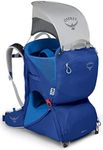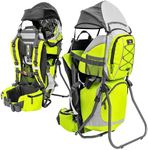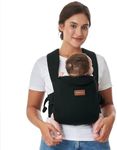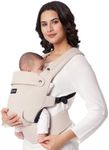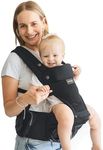Buying Guide for the Best Backpack Child Carriers
Choosing the right backpack child carrier is essential for ensuring both your comfort and your child's safety during outdoor adventures. When selecting a carrier, consider factors such as the duration of your trips, the terrain you'll be navigating, and the age and weight of your child. A well-chosen carrier can make your hiking experience enjoyable and stress-free. Here are some key specifications to consider when picking a backpack child carrier.Weight CapacityWeight capacity refers to the maximum weight the carrier can safely hold, including your child and any additional gear. This spec is crucial because exceeding the weight limit can compromise the carrier's stability and your comfort. Weight capacities typically range from 40 to 60 pounds. If your child is younger and lighter, a lower capacity may suffice, but for older or heavier children, opt for a higher capacity to ensure safety and longevity.
AdjustabilityAdjustability includes features like adjustable shoulder straps, hip belts, and back panels. These adjustments are important for achieving a comfortable fit for different body types and for distributing weight evenly. Carriers with multiple adjustment points can be tailored to fit both parents, making it easier to share carrying duties. Look for carriers with easy-to-use adjustment mechanisms and ensure they can accommodate your height and torso length.
Safety FeaturesSafety features include harness systems, leg openings, and stability mechanisms that keep your child secure. A good harness system should be easy to buckle and adjust, providing a snug fit without being too tight. Leg openings should be padded and designed to prevent chafing. Stability features like a kickstand can help keep the carrier upright when loading and unloading your child. Prioritize carriers with comprehensive safety features to ensure your child's well-being.
ComfortComfort for both the parent and child is essential for long hikes. Look for carriers with padded shoulder straps, hip belts, and lumbar support to reduce strain on your back and shoulders. For the child, a padded seat and adjustable stirrups can enhance comfort. Ventilation is also important to prevent overheating, so consider carriers with breathable materials and mesh panels. Test the carrier with your child to ensure it feels comfortable for both of you.
Storage OptionsStorage options refer to the compartments and pockets available for carrying essentials like diapers, snacks, and water bottles. Ample storage is important for keeping your hands free and ensuring you have everything you need for your hike. Carriers with multiple pockets and compartments can help you stay organized. Consider how much gear you typically carry and choose a carrier with sufficient storage to meet your needs.
Weight of the CarrierThe weight of the carrier itself can impact your overall comfort, especially on longer hikes. Lighter carriers are easier to carry but may have fewer features, while heavier carriers often include more padding and storage options. Balance the carrier's weight with the features you need. If you plan on long hikes, a lighter carrier may be preferable, but for shorter trips, a heavier carrier with more features might be more suitable.
Ease of UseEase of use encompasses how simple it is to load and unload your child, adjust the carrier, and access storage compartments. A user-friendly carrier can save time and reduce frustration. Look for carriers with intuitive designs, clear instructions, and features like quick-release buckles. Test the carrier to ensure you can easily operate all its functions, especially if you'll be using it frequently or in challenging conditions.



